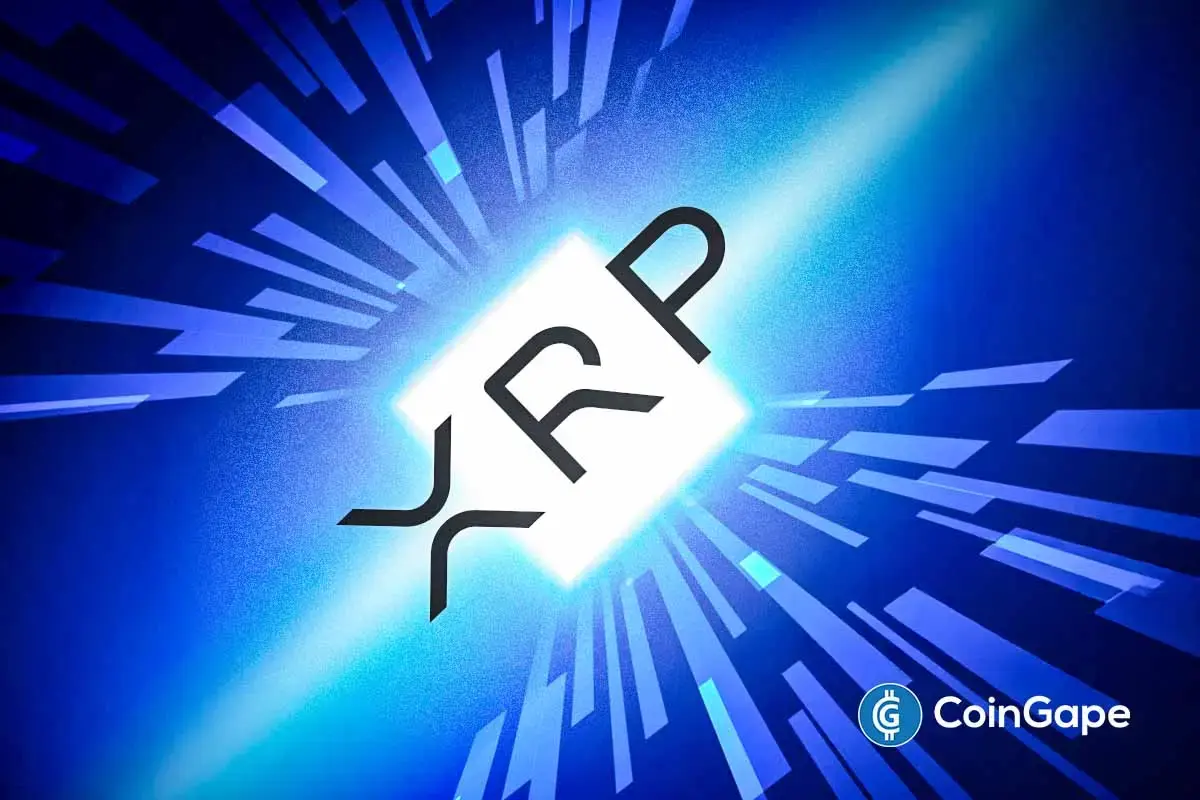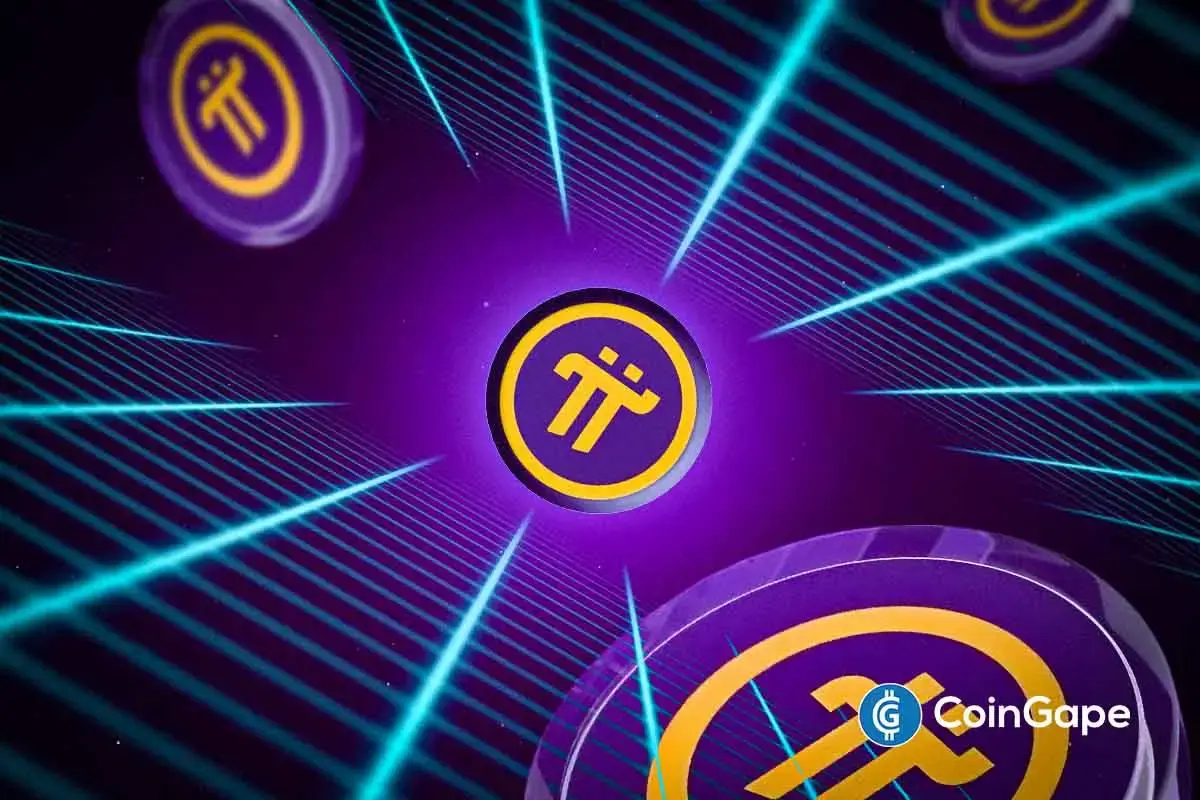Market
Toncoin (TON) Price Stabilizes, Setting the Stage for a Shift

Toncoin (TON) price has experienced a significant rise in its Relative Strength Index, moving from an oversold position to a neutral level. Despite this increase, the RSI remains in a neutral range, indicating no clear trend dominance.
Additionally, the stable supply of TON on exchanges suggests traders are hesitant to commit to major moves. With the EMA lines showing a weak bearish alignment, TON appears to be in a consolidation phase.
TON RSI Is Currently Neutral
TON’s RSI is currently at 45.56, a notable increase from 30 on October 9. This recent uptick indicates that buying momentum has improved, with a recovery from oversold conditions just a few days ago. The move up from 30 suggests that selling pressure has significantly weakened, leading to a stabilization in price action.
However, despite this upward shift, the RSI is still within a neutral range. The current level reflects a market in transition, where neither buyers nor sellers have taken firm control.
RSI, or Relative Strength Index, is a momentum oscillator used to gauge the speed and magnitude of recent price changes. RSI values above 70 indicate an asset may be overbought, suggesting a possible pullback. On the other hand, values below 30 typically signal oversold conditions, often hinting at a potential reversal upward.
Read more: 6 Best Toncoin (TON) Wallets in 2024

TON’s current RSI of 45 sits comfortably between these extremes. In this neutral zone, RSI does not offer a clear directional cue, implying that TON price might continue its consolidation phase.
The market appears to be searching for clarity, with current momentum insufficient to drive a strong breakout or breakdown. As a result, it’s entirely possible that TON remains range-bound in the near term, waiting for a more definitive catalyst to shift its trend direction.
Toncoin Supply On Exchanges Is Stable
Between September 29 and October 2, TON’s supply on exchanges declined substantially, dropping from 2.29 million to 1.56 million. This significant reduction suggests that many holders were withdrawing their tokens from exchanges, possibly moving them to personal wallets. Since then, however, the supply on exchanges has risen slightly, now sitting at 1.63 million.
This partial recovery may indicate some traders are preparing to re-enter the market, potentially seeking trading opportunities. Despite this rebound, the overall supply remains well below the late September levels, showing a shift in investor sentiment compared to the prior surge in exchange balances.
Typically, when a coin’s supply on exchanges increases, it’s seen as a bearish signal. Coins moved to exchanges are often intended for selling, creating additional selling pressure.

This is exactly what happened during the early October period for TON, when the price dropped from $5.88 to $5.34 in response to increased exchange supply. However, the recent stability in the supply of TON on exchanges suggests that the market may not currently have a strong directional bias.
The relative stability of around 1.63 million implies that traders and investors are waiting on the sidelines, neither accumulating in personal wallets nor preparing for a significant sell-off. This period of calm indicates indecision, as market participants are waiting for clearer signals before making further moves.
This suggests that TON may remain in a consolidation phase until a catalyst shifts the balance either way.
TON Price Prediction: Possible Rebound Back to $6.13?
Currently, TON’s EMA lines indicate a bearish trend, with short-term moving averages positioned below the long-term ones. This alignment typically signals that downward pressure is prevailing. However, the distance between the short-term and long-term EMAs is quite small, suggesting that the bearish trend may not be particularly strong.
When these moving averages are close to each other, it implies that price momentum is not decisively negative, and any shift in market sentiment could quickly alter the trend direction. The convergence of these lines is a sign of uncertainty, indicating that traders should be cautious before making assumptions about a sustained downturn.
EMA, or Exponential Moving Average, is a technical indicator used to track the average price of an asset over a specific period. It gives more weight to recent price data to better reflect momentum. Short-term EMA lines respond quickly to price changes, while long-term EMAs are slower to react.
Read more: Top 9 Telegram Channels for Crypto Signals in October 2024
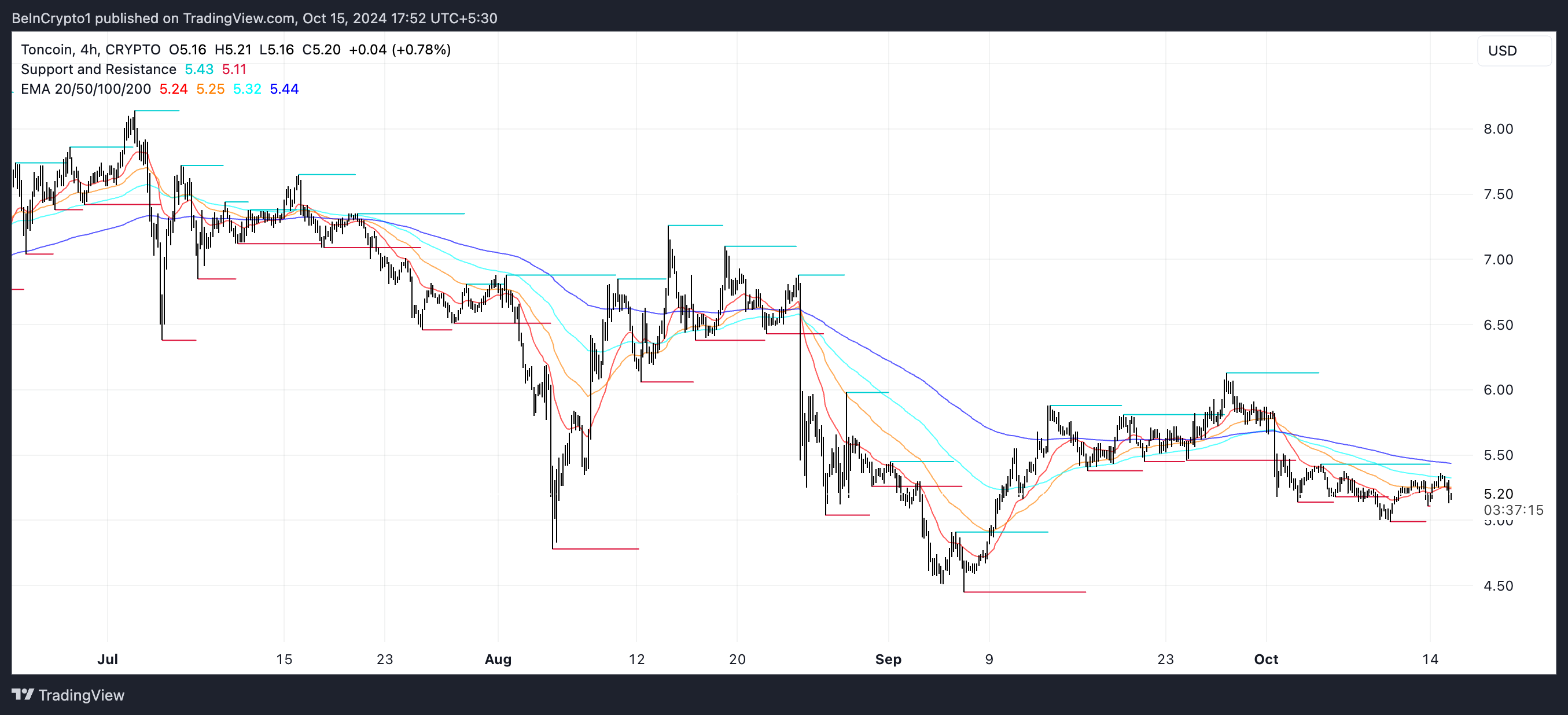
When the short-term EMA falls below the long-term EMA, it signals that recent price action is weaker compared to the longer trend. This is typically interpreted as bearish.
If this current downtrend in TON becomes more pronounced, the price could test lower support levels, potentially dropping to $4.99 or even $4.78. However, should sentiment improve and the trend reverse, TON price could recover to retest the $5.88 zone and possibly move higher to $6.13, suggesting a renewed bullish momentum.
The small gap between EMA lines makes both scenarios possible, depending on how market forces evolve.
Disclaimer
In line with the Trust Project guidelines, this price analysis article is for informational purposes only and should not be considered financial or investment advice. BeInCrypto is committed to accurate, unbiased reporting, but market conditions are subject to change without notice. Always conduct your own research and consult with a professional before making any financial decisions. Please note that our Terms and Conditions, Privacy Policy, and Disclaimers have been updated.
Market
Report Alleges Massive Meme Coin Sniping on Pump.fun

According to a new report from Pine Analytics, token deployers on Pump.fun systematically funded sniper wallets to buy their own meme coins. This impacted over 15,000 token launches on the platform.
These sniper wallets operated primarily during US trading hours, executing standardized, profitable strategies. Unrelated bot activity obscures their behavior, making it extremely difficult to isolate these wallets—and they can readily adapt to new countermeasures.
Snipers Roam Free on Pump.fun Meme Coins
Pump.fun has remained one of the most popular meme coin launchpads on Solana despite persistent controversies and other criticism.
However, Pine Analytics’ new report has uncovered a new controversy, discovering systematic market manipulation on the platform. These snipes include as much as 1.75% of all launch activity on Pump.fun.
“Our analysis reveals that this tactic is not rare or fringe — over the past month alone, more than 15,000 SOL in realized profit was extracted through this method, across 15,000+ launches involving 4,600+ sniper wallets and 10,400+ deployers. These wallets demonstrate unusually high success rates (87% of snipes were profitable), clean exits, and structured operational patterns,” it claimed.
Solana meme coin deployers on Pump.fun follow a consistent pattern. They fund one or more sniper wallets and grant them advance notice of upcoming token launches.
Those wallets purchase tokens in the very first block and then liquidate almost immediately—85% within five minutes and 90% in just one or two swap events.

Pump.fun meme coin developers exploit this tactic to create the appearance of immediate demand for their tokens. Retail investors, unaware of the prior sell‑off, often purchase these tokens after the snipe, giving developers an unfair advantage. This constitutes market manipulation and erodes trust in the platform.
Pine Analytics had to carefully calibrate its methods to identify genuine snipers. Apparently, 50% of meme coin launches on Pump.fun involve sniping, but most of this is probably bots using the “spray and pray” method.
However, by filtering out snipers with no direct links to developer wallets, the firm missed projects that covered their tracks through proxies and burners.
In other words, the meme coin community does not have adequate defenses against systematic abuse on Pump.fun. There are a few possible ways that the platform could flag repeat offenders and sketchy projects, but adaptive countermeasures could defeat them. This problem demands persistent and proactive action.
Unfortunately, it may be difficult to enact such policies. Meme coin sniping is so systematic that Pump.fun could only fight it with real commitment.
Analysts think that building an on-chain culture that rewards transparency over extraction is the best long-term solution. A shift like that would be truly seismic, and the meme coin sector might not survive it.
Disclaimer
In adherence to the Trust Project guidelines, BeInCrypto is committed to unbiased, transparent reporting. This news article aims to provide accurate, timely information. However, readers are advised to verify facts independently and consult with a professional before making any decisions based on this content. Please note that our Terms and Conditions, Privacy Policy, and Disclaimers have been updated.
Market
Solana Leads Blockchain Metrics as SOL Momentum Builds

Solana (SOL) continues to show strength across multiple fronts, maintaining a bullish structure on its Ichimoku Cloud chart while gaining momentum in key market metrics. The BBTrend indicator has turned higher again, signaling renewed buying pressure after a brief cooldown.
On-chain activity remains strong, with Solana leading all blockchains in DEX volume and dominating fee generation thanks to the explosive growth of meme coins and launchpad activity. With SOL now trading above a key resistance level, the path is open for further upside—though a loss of momentum could still trigger a retest of lower supports.
Solana Maintains Bullish Structure, but Momentum Faces Key Test
On Solana’s Ichimoku Cloud chart, the price is currently above the Kijun-sen (red base line) but has dipped below the Tenkan-sen (blue conversion line), signaling weakening short-term momentum.
The flattening Tenkan-sen and price behavior suggest possible consolidation or the early stages of a pullback. Still, with the price holding above the Kijun-sen, medium-term support remains intact.
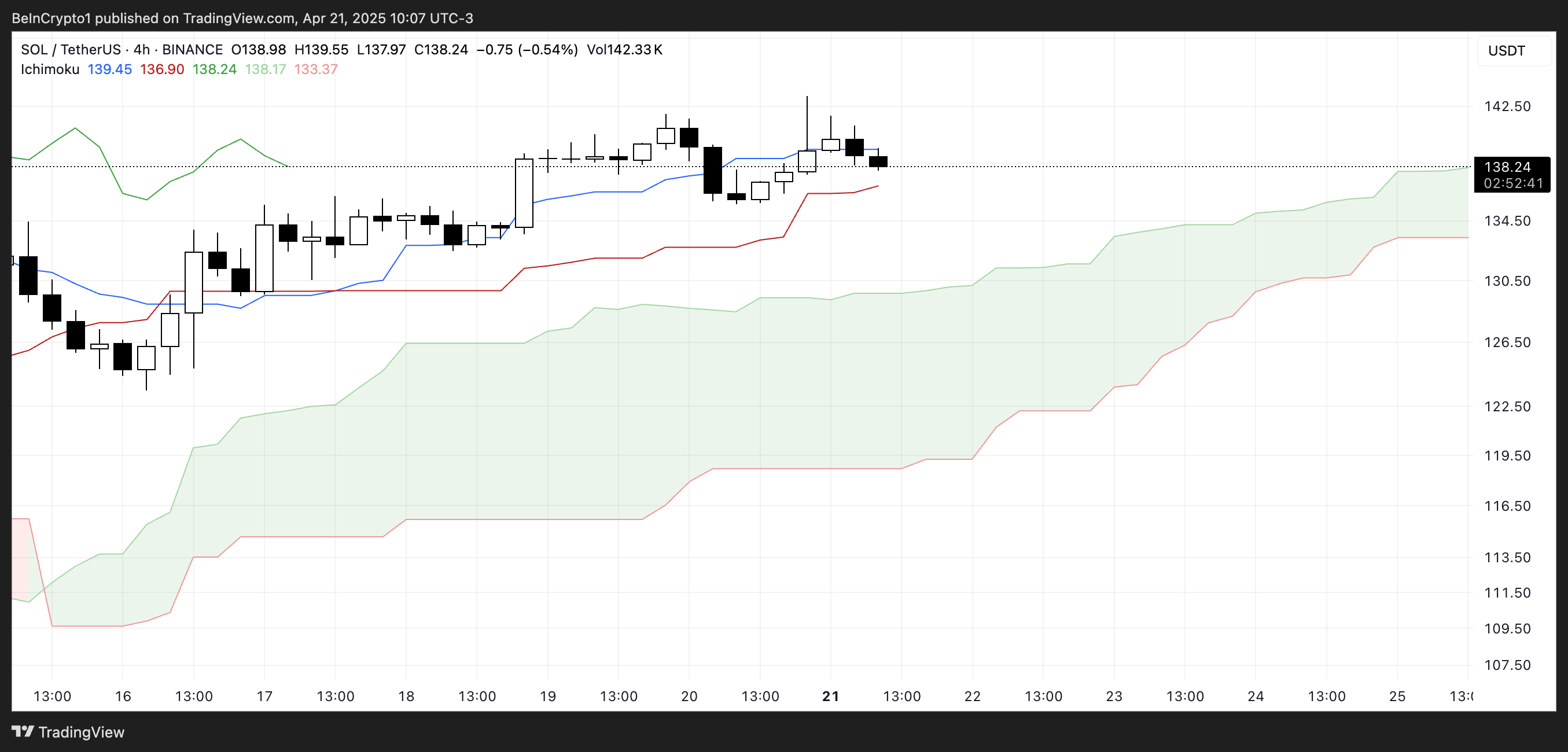
The overall Ichimoku structure remains bullish, with a thick, rising cloud and leading span A well above span B—indicating strong underlying support.
If Solana finds support at the Kijun-sen and climbs back above the Tenkan-sen, the uptrend could regain strength; otherwise, a test of the cloud’s upper boundary may follow.

Meanwhile, Solana’s BBTrend is currently at 6, extending nearly ten days in positive territory after peaking at 17.5 on April 14. The recent increase from 4.26 to 6 suggests renewed bullish momentum following a brief cooldown.
BBTrend, or Bollinger Band Trend, tracks the strength of price movement based on Bollinger Band expansion.
Positive values like the current one point to an active uptrend, and if the BBTrend continues to rise, it could signal stronger momentum and potential for another upward move.
Solana Dominates DEX Volume and Fee Generation as Meme Coins Drive Ecosystem Growth
Solana has once again claimed the top spot among all chains in DEX volume, recording $15.15 billion over the past seven days. The combined total of Ethereum, BNB, Base, and Arbitrum reached $22.7 billion.

In the last 24 hours alone, Solana saw $1.67 billion in volume, largely fueled by its booming meme coin ecosystem and the ongoing launchpad battle between PumpFun and Raydium. Adding to this good momentum, Solana recently surpassed Ethereum in Staking Market Cap.

When it comes to application fees, Solana’s momentum is just as clear. Four of the top ten fee-generating apps over the past week—PumpFun, Jupiter, Jito, and Meteora—are Solana-focused.
Pump leads the pack with nearly $18 million in fees alone.
Solana Breaks Key Resistance as Uptrend Targets Higher Levels, but Risks Remain
Solana has finally broken above its key resistance at $136, flipping it into a new support level that was successfully tested just yesterday.
Its EMA lines remain aligned in a bullish setup, suggesting the uptrend is still intact.
If this momentum continues, SOL price could aim for the next resistance zones at $147 and $152—levels that, if breached, open the door to a potential move toward $179.
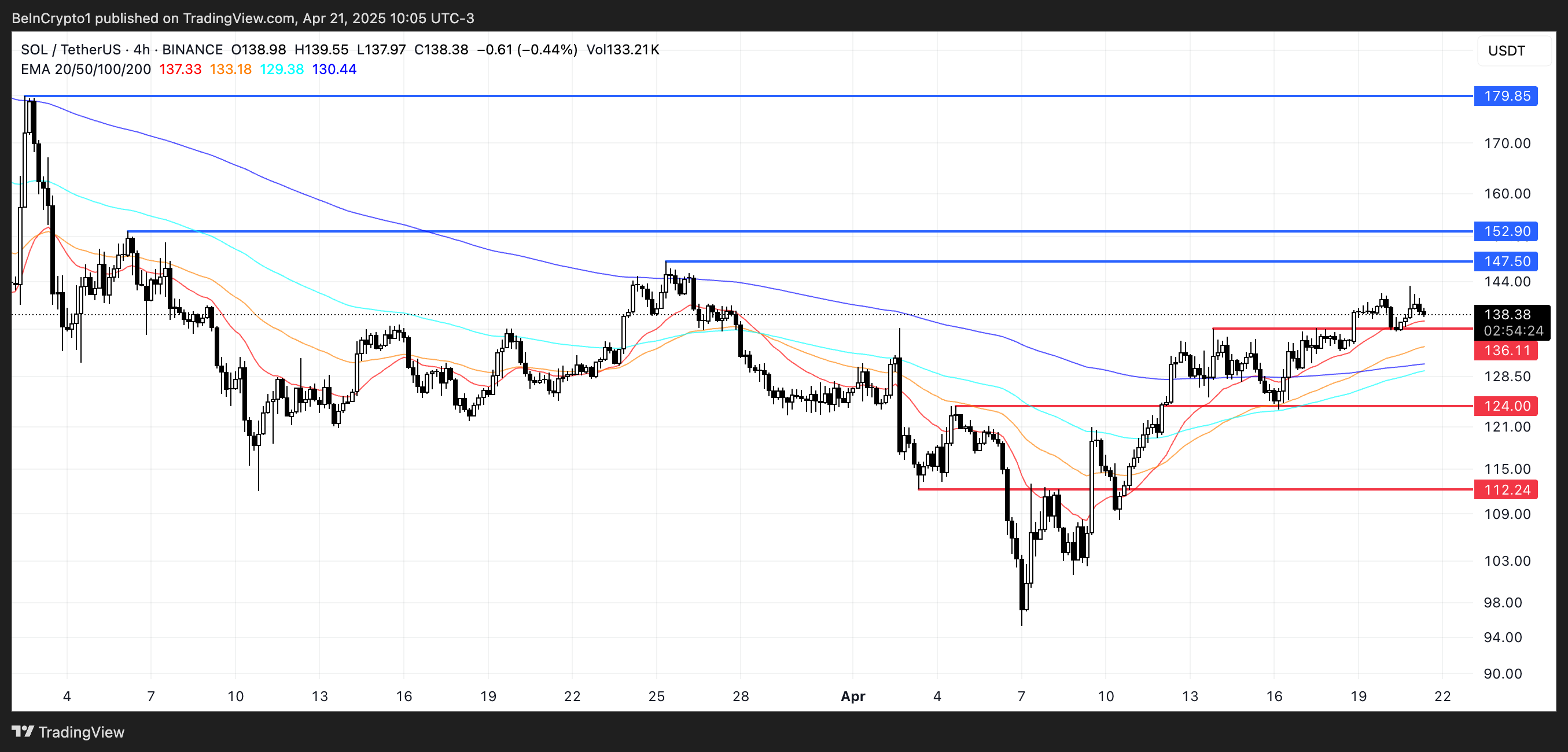
The current structure favors buyers, with higher lows and strong support reinforcing the trend.
However, if momentum fades, a retest of the $136 support is likely.
A breakdown below that level could shift sentiment, exposing Solana to deeper pullbacks toward $124 and even $112.
Disclaimer
In line with the Trust Project guidelines, this price analysis article is for informational purposes only and should not be considered financial or investment advice. BeInCrypto is committed to accurate, unbiased reporting, but market conditions are subject to change without notice. Always conduct your own research and consult with a professional before making any financial decisions. Please note that our Terms and Conditions, Privacy Policy, and Disclaimers have been updated.
Market
Crypto Firms Donated $85 million in Trump’s Inauguration
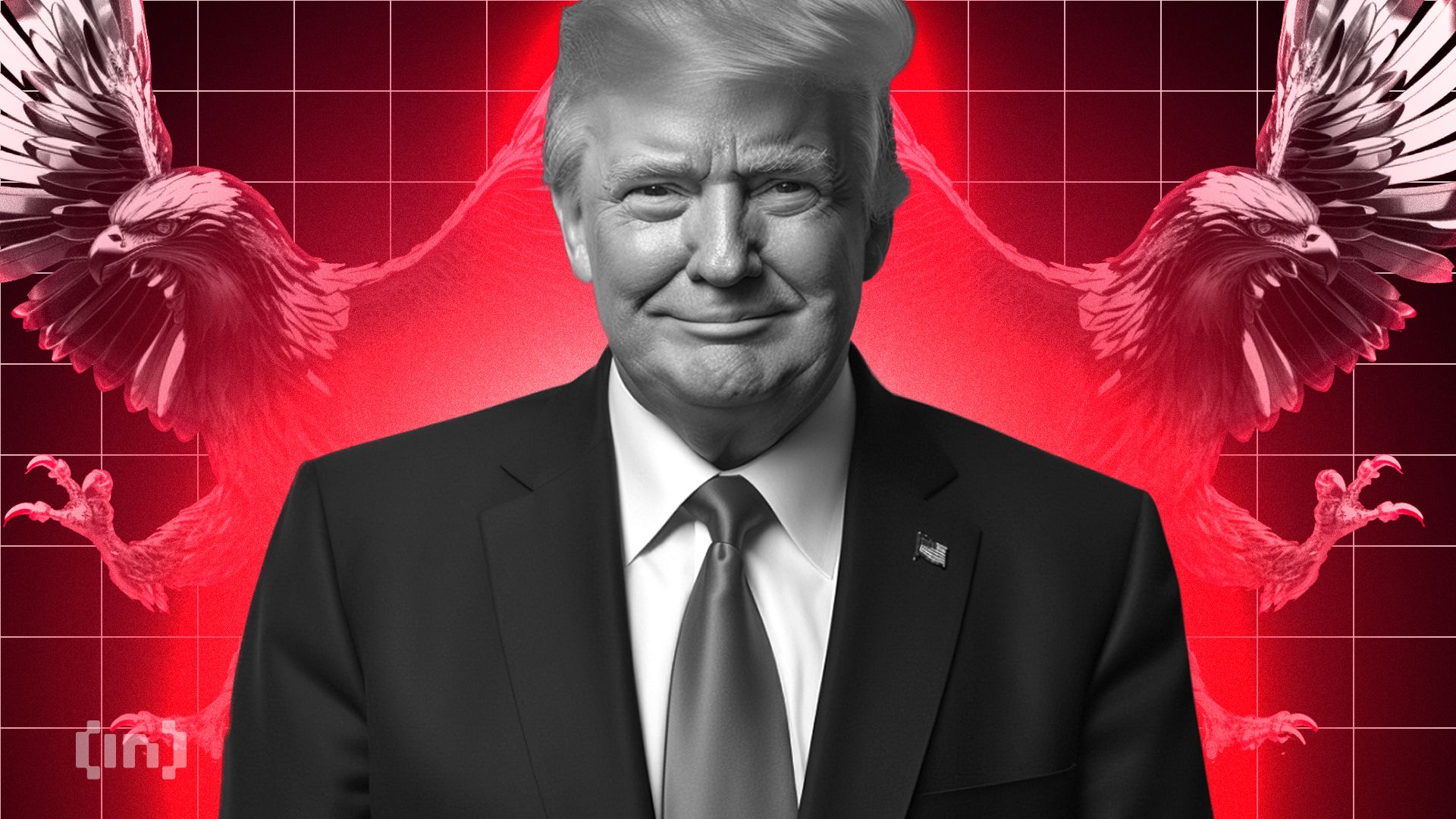
According to a new report, 15 firms and individuals from the crypto industry donated more than $100,000 to President Trump’s Inauguration, totaling over $85 million.
Almost all of these companies apparently received direct or indirect benefits from Trump’s administration. This includes dropped legal proceedings, lucrative business partnerships, participation in Trump’s Crypto Summit, and more.
Crypto Industry Went All-In on Trump’s Inauguration
Since promising to bring friendlier regulations on the campaign trail, Donald Trump attracted a reputation as the Crypto President.
Trump’s Inauguration festivities included a “Crypto Ball,” and several prominent firms made donations for these events. Today, a report has compiled all crypto-related contributions of over $100,000, revealing some interesting facts.

Since taking office, President Trump and his family have been allegedly involved in prominent crypto controversies, and these donations may be linked to several of them.
For example, eight of the donors, Coinbase, Crypto.com, Uniswap, Yuga Labs, Kraken, Ripple, Robinhood, and Consensys, had SEC investigations or lawsuits against them closed since Trump’s term began.
The commission might have dropped its probe against these companies anyway due to its changing stance on crypto enforcement. However, being in the President’s good books likely helped the process.
Further Alleged Benefits for Donors
In other words, nearly half the firms that made donations to Trump’s Inauguration have seen their legal problems cleared up quickly. This isn’t the only regulation-related benefit they allegedly received.
Circle, for example, recently made an IPO after openly stating that Trump’s Presidency made it possible. Galaxy Digital received SEC approval for a major reorganization, a key step for a NASDAQ listing.
Other donors, such as Crypto.com and ONDO, got more direct financial partnerships with businesses associated with the Trump family.
Previously, Ripple’s CEO, Brad Garlinghouse, anticipated a crypto bull market under Trump. Also, XRP, Solana, and Cardano were all unexpectedly included in the US Crypto Reserve announcement.
All three of these companies made major donations to Trump’s Inauguration.
It seems that most of the firms involved got at least some sort of noticeable benefit from these donations. Donors like Multicoin and Paradigm received invitations to Trump’s Crypto Summit, while much more prominent groups like the Ethereum Foundation got snubbed.
Meanwhile, various industry KOLs and community members have already alleged major corruption in Trump’s crypto connections.
While some allegations might lack substantial proof, the crypto space has changed dramatically under the new administration, for both good and bad.
Disclaimer
In adherence to the Trust Project guidelines, BeInCrypto is committed to unbiased, transparent reporting. This news article aims to provide accurate, timely information. However, readers are advised to verify facts independently and consult with a professional before making any decisions based on this content. Please note that our Terms and Conditions, Privacy Policy, and Disclaimers have been updated.



